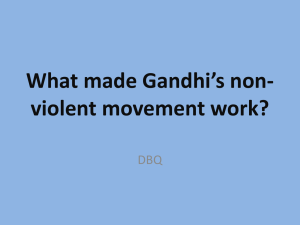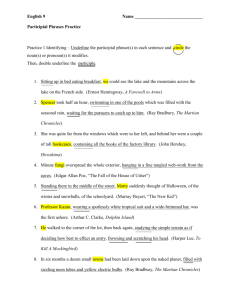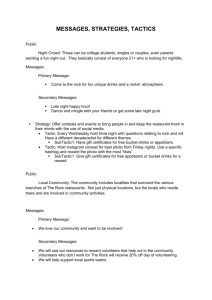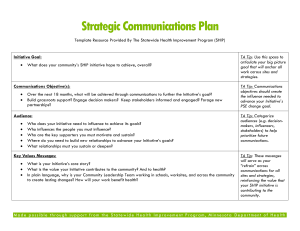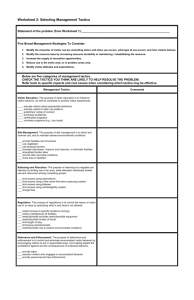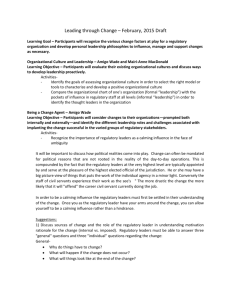Sample Abbreviated Campaign - Drexel University
advertisement
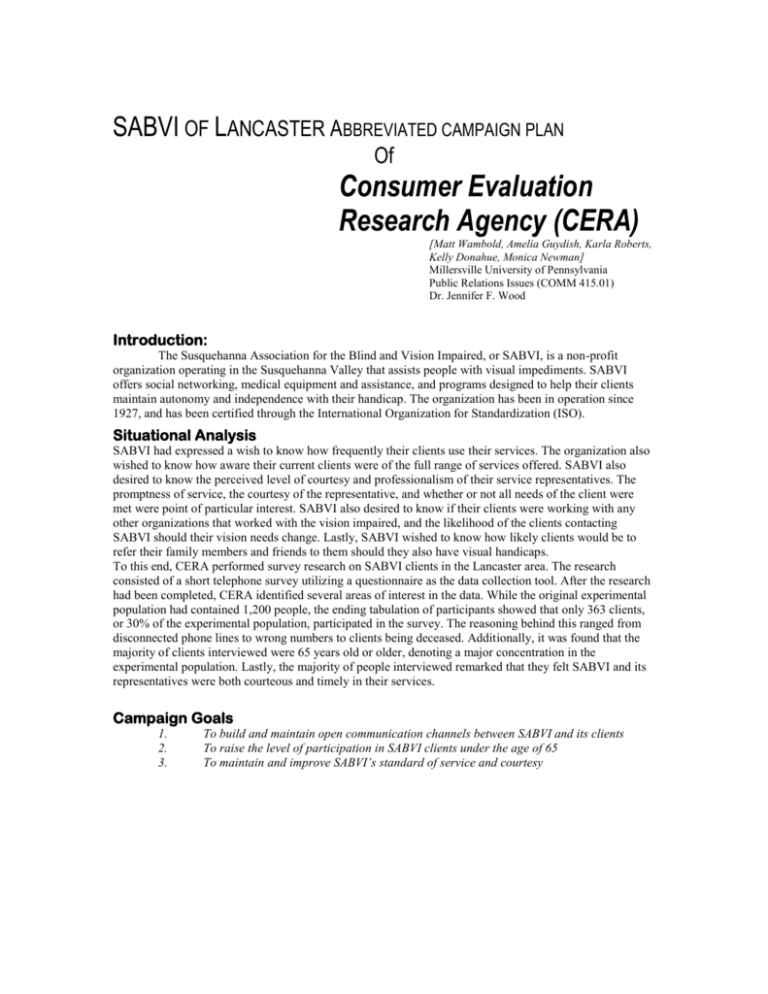
SABVI OF LANCASTER ABBREVIATED CAMPAIGN PLAN Of Consumer Evaluation Research Agency (CERA) [Matt Wambold, Amelia Guydish, Karla Roberts, Kelly Donahue, Monica Newman] Millersville University of Pennsylvania Public Relations Issues (COMM 415.01) Dr. Jennifer F. Wood Introduction: The Susquehanna Association for the Blind and Vision Impaired, or SABVI, is a non-profit organization operating in the Susquehanna Valley that assists people with visual impediments. SABVI offers social networking, medical equipment and assistance, and programs designed to help their clients maintain autonomy and independence with their handicap. The organization has been in operation since 1927, and has been certified through the International Organization for Standardization (ISO). Situational Analysis SABVI had expressed a wish to know how frequently their clients use their services. The organization also wished to know how aware their current clients were of the full range of services offered. SABVI also desired to know the perceived level of courtesy and professionalism of their service representatives. The promptness of service, the courtesy of the representative, and whether or not all needs of the client were met were point of particular interest. SABVI also desired to know if their clients were working with any other organizations that worked with the vision impaired, and the likelihood of the clients contacting SABVI should their vision needs change. Lastly, SABVI wished to know how likely clients would be to refer their family members and friends to them should they also have visual handicaps. To this end, CERA performed survey research on SABVI clients in the Lancaster area. The research consisted of a short telephone survey utilizing a questionnaire as the data collection tool. After the research had been completed, CERA identified several areas of interest in the data. While the original experimental population had contained 1,200 people, the ending tabulation of participants showed that only 363 clients, or 30% of the experimental population, participated in the survey. The reasoning behind this ranged from disconnected phone lines to wrong numbers to clients being deceased. Additionally, it was found that the majority of clients interviewed were 65 years old or older, denoting a major concentration in the experimental population. Lastly, the majority of people interviewed remarked that they felt SABVI and its representatives were both courteous and timely in their services. Campaign Goals 1. 2. 3. To build and maintain open communication channels between SABVI and its clients To raise the level of participation in SABVI clients under the age of 65 To maintain and improve SABVI’s standard of service and courtesy SABVI of Lancaster Campaign CERA, 2 of <?> Key Publics Several Key publics were identified during the research stage pertinent to the overall goals of this campaign. In terms of external publics, a broad group of the entire Lancaster clientele can be seen as a key public, holding that communication with these individuals is needed to complete the first goal. This group could be subdivided to yield another key public, this one being clients under the age of 65. As this demographic is considered a minority in the overall population of SABVI clients, they are subject to a reduced voice and are less likely to participate in the programs SABVI provides. As for internal publics, the representatives and other teaching staff can be seen as a key public. The reasoning behind this is that these educators are the ones who interact with clients, and have been rated by the clients as providing excellent service. This level of proficiency must be maintained and improved upon for the sake of the third objective. Additionally, the clerical staff of SABVI are a target internal public. The reasoning for this is that, if constant communication with clients is to be kept, these individuals will be the ones most directly involved in this. Campaign Theme & Key Messages This campaign will be entitled “There for You.” The primary focus behind this campaign will be to stress the empathetic nature of the organization as well as focus on their desire to maintain an excellent rapport with its clientele. The campaign will focus on improving interaction with clients and keeping data concerning clients up to date. The campaign will also seek to improve participation and membership in demographics under the age of 65. Finally, the campaign will seek to exemplify the service provided by its representatives, as well as inform the public that SABVI will seek to improve the service it provides through the input of the clients. Ideally, the key messages will pertain to the creation and maintaining of strong SABVI/client relationships. The theme of this campaign, “There for You”, exemplifies the relationship that SABVI will build and maintain with its clients. With regards to the maintaining of strong communication with the whole client population, SABVI will be “there for” its clients, keeping in touch and checking in to ensure that everything is all right. Regarding the under 65 demographics, SABVI will take a more active role in discovering what would interest them and providing programs that would encourage them to participate. In this respect, SABVI will be “there for” these other groups, showing them that their voice is not lost. Finally, with the maintaining and improvement of services provided, SABVI will be “there for” its clients, ensuring that they will provide the services they need and work to constantly improve their already excellent customer service. This particular campaign will run for one year. This will ensure that the data collected is representative of client participation throughout the entire calendar year. Additionally one year will provide enough time to update contact data for SABVI, as well as create and implement school-based information presentations during at least two parts of the academic year. Additionally, a year will provide enough feedback concerning representative and educator performance to know if standards have been maintained, and even improved. Finally, by allowing the campaign to run the full course of a year, programs for the under 65 age demographics will be able to take advantage of the shifting seasons and holiday events. SABVI of Lancaster Campaign CERA, Page 3 of 6 Objectives, Message Strategies, Tactics, and Output Evaluation _____________________________________________________________________________________________________________________ ___________________________________________________________________________________________________ GOAL: TO BUILD AND MAINTAIN OPEN COMMUNICATION CHANNELS BETWEEN SABVI AND ITS CLIENTS ___________________________________________________________________________________________________________________________________________________________________________________________________ _____________________ Objective 1: Update client information and keep it current Message strategy A: Communicate with clients and ensure contact information is valid Tactic 1: Commit staff and resources to calling clients and verifying information Output/Tactic Evaluation: Verifying that all contact data on clients is up to date Tactic 2: After initial check, calling clients every month to ensure that contact data is still up to date Output/Tactic Evaluation: Verifying that data originally collected is still valid, or if data has changed, that the client’s contact data has been changed accordingly. Message strategy B: Ensure that clients lost from the system (e.g.: deceased, line disconnected, no longer participating) are removed from the system promptly Tactic 1: Remove contact information of clients who no longer actively participate Output/Tactic Evaluation: Contact information reflects clients who actively participate in SABVI programs Tactic 2: If clients request to be removed from calling list/ programs, politely ask for reasoning Output/Tactic Evaluation: Data from clients that request removal from system, which can be used to improve overall interaction with clients _____________________________________________________________________________________________________________________________ ___________________________________________________________________________________________ \ _____________________________________________________________________________________________________________________________ ___________________________________________________________________________________________ GOAL: TO RAISE THE LEVEL OF PARTICIPATION IN SABVI CLIENTS UNDER THE AGE OF 65 _____________________________________________________________________________________________________________________________ ___________________________________________________________________________________________ Objective 1: Increase membership of age groups under 65 years old Message strategy A: Increase visibility of SABVI to desired age groups Tactic 1: Information presentation in local school target towards preteen/teen age groups Output/Tactic Evaluation: Survey presented at the end of presentation, as well as any marked increase in membership in denoted areas Tactic 2: Set up a kiosk/ informational booth in a local mall/high traffic area with chance to fill out contact information forms Output/Tactic Evaluation: Increased membership in client groups under 65, contact information sheets Objective 2: Increase number of provided programs that appeal to age groups under 65 years old Message strategy A: Research what programs clients from desired demographics would enjoy Tactic 1: Conduct telephone survey asking specified clients what programs they would enjoy Output/Tactic Evaluation: Questionnaire data acquired from survey Tactic 2: Transmit possible program data over South Central Audio Network, encourage response from clients Output/Tactic Evaluation: Input gathered from clients Message strategy B: Implement programs that clients from under 65 age group would enjoy Tactic 1: Test run some programs (i.e.: trips to Franklin Institute, Philadelphia Zoo, ect.) Output/Tactic Evaluation: Short intercept survey of participants Tactic 2: Once test run have been made, implement highest ranking programs Output/Tactic Evaluation: Survey of those participating, general data so to number of participants _____________________________________________________________________________________________________________________________ ___________________________________________________________________________________________ SABVI of Lancaster Campaign CERA, Page 4 of 6 _____________________________________________________________________________________________________________________________ ___________________________________________________________________________________________ GOAL: TO MAINTAIN AND IMPROVE SABVI’S STANDARD OF SERVICE AND COURTESY _____________________________________________________________________________________________________________________________ ___________________________________________________________________________________________ Objective 1: Establish the perceived level of courtesy and service Message strategy A: Create a baseline of service and courtesy Tactic 1: Have clients answer questions pertaining to levels of service and courtesy at the end of all sessions through questionnaires/verbal responses Output/Tactic Evaluation: Questionnaire data acquired from participating clients Tactic 2: Request monthly reviews of data on representative performance from active clients Output/Tactic Evaluation: Review from clients; can possibly included in monthly checkup (see Goal 1, Objective 1) Objective 2: Monitor levels of courtesy and service for positive and negative change Message strategy A: Evaluate individual educator/representative performance Tactic 1: Have every client specify representative providing service during evaluations Output/Tactic Evaluation: Data from clients pertaining to each representative Tactic 2: Reference data provided by clients against established baseline for representative Output/Tactic Evaluation: Variances in performance will be monitored to ensure quality control Message strategy B: Ensure baseline is kept or improved upon Tactic 1: Require refreshers for representatives to ensure they are kept up to date on services and the instruction therein Output/Tactic Evaluation: Quality of service provided by representatives is measured against baseline _____________________________________________________________________________________________________________________________ ___________________________________________________________________________________________ Campaign Timetable In this year-long campaign, several tactics will be used with varying timetables. With regards to the tactics used in Goal #1, the majority of those tactics will be used year round. This is to ensure that the data on clients is kept as up to data as possible. Regarding Goal#2, the in-school educational presentations will be limited to the constraints of the academic year. The tactics pertaining to public presentations and the generation of possible programs will be run during the full year so as to receive feedback concerning seasonal activities. For Goal #3, the tactics will be run year-long. With the need to establish and monitor a baseline of customer satisfaction and representative courtesy, data must be collected throughout the full year to ensure the most accurate data possible. ______________________________________________________________________________________ Jan Feb March April May June July Aug, Sept. Tactics Data Collection Follow-Up Collection Data Removal Removal rationale Information Presentation Information Booths Telephone Survey SCAN Transmission Program Tests Program Implementation Representative Reviews Monthly Reviews Representative Data Baseline Check Refreshers x----------x----------x-----------x----------x-----------x----------x-----------x-----------x x----------x----------x-----------x----------x-----------x----------x-----------x-----------x x----------x----------x-----------x----------x-----------x----------x-----------x-----------x x----------x----------x-----------x----------x-----------x----------x-----------x-----------x x x x x x x x x x x x x x x x x x x x x x x x x-----------x----------x-----------x----------x-----------x----------x-----------x----------x x----------x-----------x----------x-----------x----------x-----------x----------x x-----------x-----------x----------x----------x-----------x----------x-----------x----------x x-----------x----------x-----------x----------x-----------x----------x-----------x----------x x-----------x----------x-----------x----------x-----------x----------x-----------x----------x x-----------x----------x-----------x----------x-----------x----------x-----------x----------x x----------x-----------x----------x-----------x----------x-----------x----------x _____________________________________________________________________________ SABVI of Lancaster Campaign CERA, Page 5 of 6 Campaign Budget Table 1.1 Narrative Budget By Activities _______________________________________________________________________________ Program Costs Administrative Costs Total Costs _______________________________________________________________________________ Plan Activity #1 Informational Presentation $1,500 x 2 $0 $ 3,000 #2 Informational Booths $2,500 x 4 $0 $ 10,000 #3 Service Refreshers $1,000 x 12 $0 $ 12,000 #4 Under 65 Programs $ 2,500x 11 $0 $ 27,500 ____________ ________________ _________ Program Costs Administrative Costs Total Cost ____________ ________________ _________ $ 55,000 $0 $52,500 _____________________________________________________________________________ Activity 1 Informational Presentation- Presentation given in local schools to raise awareness about SABVI. Given twice a year Activity 2 Informational Booths- Kiosks set up in local malls to give out information and allow for sign up of new members. Done four times a year Activity 3 Service Refreshers- Mandatory programs to ensure that representatives are up to data ton programs they are teaching. Implemented 11 times a year Activity 4 Under 65 Programs- Programs designed to increase interest in SABVI among clients under age of 65. To be implemented year round. _____________________________________________________________________________ SABVI of Lancaster Campaign CERA, Page 6 of 6 Evaluation Methods/Conclusions In this section, discuss your output and outcome evaluation. Then you may begin by stating that “each output evaluation is outlined with its corresponding tactic.” After that you may discuss your outcome (which are equivalent to your goals) evaluation. You may simply write them as statements. OUTPUTS EVALUATION: Each output’s evaluation is outlined with its corresponding tactic within the plan. The outputs for Goal #1 are measured entirely through the use of surveys and the compiling of data concerning clients. For Goal #2, the data is more geared towards an increase in participation. The outputs for the programs geared towards clients under 65 utilize a simple questionnaire to collect data concerning the effectiveness of the program. For Output #3, the use of survey data and questionnaires is vital to collecting data concerning the performance of SABVI representatives. Feedback from the clients who were served by those representatives is key to maintaining that level of professionalism and knowing where to improve. OUTCOMES EVALUATION: Recommendation 1: To evaluate the opening and maintenance of SABVI/client relations, it is recommended that data be procured from the clients concerning their current contact information. The information provided by this method will indicate any changes in residence, phone number, or state of wellbeing (deceased, disconnected, ect.). Recommendation 2: To evaluate the increasing of SABVI visibility among clients under 65 years old, it is recommended that SABVI engage in information distribution and research concerning appealing programs. By collecting data on desired programs, we will find out what clients from these particular age ranges desire in terms of a program. By implementing this data and recording the responses to the programs, it will provide information that tells us specifically what clients under the age of 65 want to see offered through SABVI. Recommendation3: To evaluate the maintenance of professionalism and courtesy among SABVI representatives, it is recommended that we (a) create a baseline level of perceived professionalism and (b) work towards maintaining and improving the level of professionalism and courtesy. These methods will provide us with information to determine if the representatives are performing their duties in a professional and courteous manner. SAMPLES: See Attached Appendices

